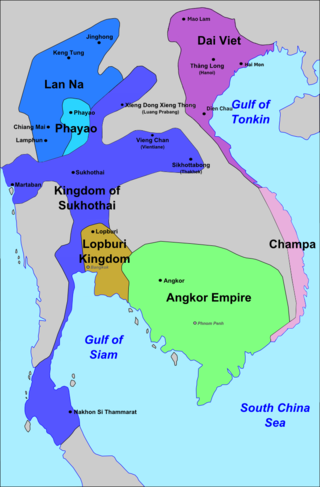
The Sukhothai Kingdom or the Northern Cities was a post-classical Thai kingdom (mandala) in Mainland Southeast Asia surrounding the ancient capital city of Sukhothai in present-day north-central Thailand. The kingdom was founded by Si Inthrathit in 1238 and existed as an independent polity until 1438, when it fell under the influence of the neighboring Ayutthaya after the death of Borommapan.

Sukhothai is one of Thailand's seventy-six provinces (changwat) lies in lower northern Thailand. Neighboring provinces are Phrae, Uttaradit, Phitsanulok, Kamphaeng Phet, Tak, and Lampang. Sukhothai can be translated as 'dawn of happiness'.
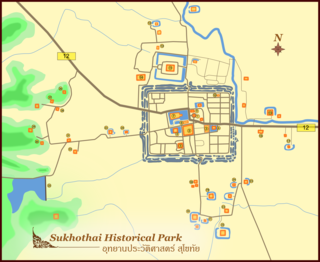
Sukhothai Historical Park covers the ruins of Sukhothai, literally 'dawn of happiness', capital of the Sukhothai Kingdom in the 13th and 14th centuries, in north central Thailand. It is near the city of Sukhothai, capital of Sukhothai Province.

Thai art refers to a diverse range of art forms created in Thailand from prehistoric times to the present day, including architecture, sculpture, painting, textiles, decorative arts, crafts, ceramics, and more. While Buddhism has played a significant role in Thai art, with many sculptures and paintings depicting Buddha images and religious themes, nature, including flora and fauna, as well as mythical creatures, has been a major inspiration for Thai art, with colorful motifs appearing in various types of art forms. In contemporary Thai art, traditional works remain significant and continue to influence artists' concepts.
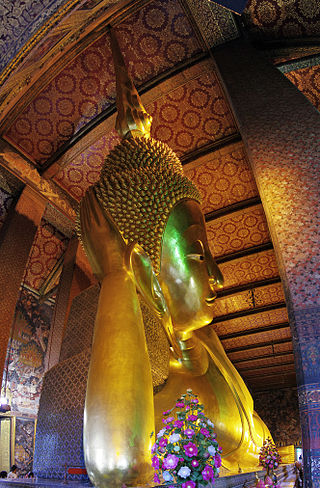
Wat Pho, also spelled Wat Po, is a Buddhist temple complex in the Phra Nakhon District, Bangkok, Thailand. It is on Rattanakosin Island, directly south of the Grand Palace. Known also as the Temple of the Reclining Buddha, its official name is Wat Phra Chetuphon Wimon Mangkhalaram Rajwaramahawihan. The more commonly known name, Wat Pho, is a contraction of its older name, Wat Photaram.
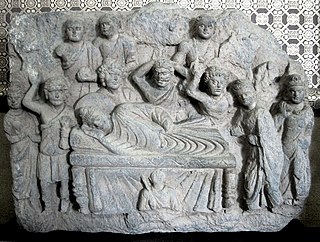
A reclining Buddha is an image that represents Buddha lying down and is a major iconographic theme in Buddhist art. It represents the historical Buddha during his last illness, about to enter the parinirvana. He is lying on his right side, his head resting on a cushion or relying on his right elbow, supporting his head with his hand.

Lampang, also called Nakhon Lampang to differentiate from Lampang province, is the third largest city in northern Thailand and capital of Lampang province and the Mueang Lampang district. Traditional names for Lampang include Wiang Lakon and Khelang Nakhon. The city is a trading and transportation center. Lampang lies 601 km (373 mi) north of Bangkok and 101 km (63 mi) southeast of Chiang Mai.
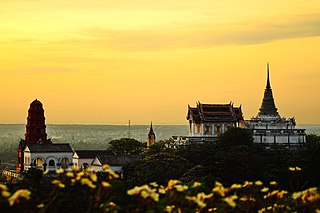
Phra Nakhon Khiri is a historical park in Phetchaburi, Thailand on a hill overlooking the city. The name Phra Nakhon Khiri means 'holy city hill', but locals know it better as Khao Wang, meaning 'hill with palace'.

Phra Pathommachedi or Phra Pathom Chedi is a Buddhist stupa in Thailand. The stupa is located in the Wat Phra Pathommachedi Ratcha Wora Maha Wihan (Thai: วัดพระปฐมเจดีย์ราชวรมหาวิหาร), a temple in the town center of Nakhon Pathom, Nakhon Pathom Province, Thailand. Phra Pathommachedi is the tallest stupa in the world. The top of its spire reaches 120.45 meters, with the base circumference of 235.50 meters.

Thai temple art and architecture is the art and architecture of Buddhist temples in Thailand. Temples are known as wats, from the Pāḷi vāṭa, meaning "enclosure". A temple has an enclosing wall that divides it from the secular world.

The Si Satchanalai Historical Park is a historical park in Si Satchanalai district, Sukhothai Province, northern Thailand. The park covers the ruins of Si Satchanalai and Chaliang. Si Satchanalai, which literally means "City of good people", was founded in 1250 as the second center of the Sukhothai Kingdom and as a residence of the crown prince in the 13th and 14th centuries.
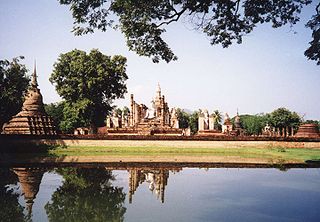
The Historic Town of Sukhothai and Associated Historic Towns is a UNESCO World Heritage Site which consists of Sukhothai historical park, Kamphaeng Phet historical park and Si Satchanalai historical park. These historical parks preserve the remains of the three main cities of the Sukhothai Kingdom which flourished during the 13th and 14th century CE. The Sukhothai Kingdom is viewed as having been the first of the Thai kingdoms.
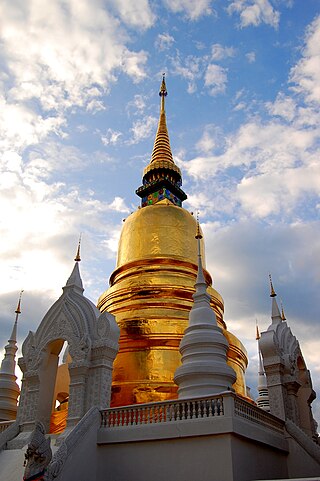
Wat Suan Dok, also known as Wat Buppharam is a Buddhist temple (Wat) in Chiang Mai, northern Thailand. It is a Royal Temple of the Third Class. The temple is on Suthep Road, approximately one kilometre west of Suan Dok gate at the west side of the moat.

Mini Siam and Mini Europe, commonly just called Mini Siam are famous miniature park attractions in Pattaya, Chonburi, Thailand. This park is located 143 km from Bangkok on Sukhumvit Road. The park houses numerous famous landmarks of Thailand within its Mini Siam, whilst other famous landmarks from outside of Thailand are located within the Mini Europe section.

Nakhon Si Thammarat City Municipality is a city municipality located in Mueang Nakhon Si Thammarat, the capital of Nakhon Si Thammarat Province. Nakhon Si Thammarat Province is situated in the South of Thailand. It is about 610 km (380 mi) south of Bangkok, on the east coast of the Malay Peninsula. The city was the administrative centre of Southern Thailand during most of its history. Originally, a coastal city, silting moved the coastline away from the city. The city has a much larger north to south extension than west to east, which dates back to its original location on a flood-save dune. The modern city centre on the train station is north of Old Town. As of 2019, the city had a population of 102,152.

Phitsanulok is a city, municipality, the capital and the largest populated place of the Thai province of Phitsanulok. It is also the headquarters of the Mueang Phitsanulok District. In 2022, it had a population of 62,000, making it the second–largest cities by population in the lower northern Thailand. The city is one of the centre of Thailand's tourism industry, and it is a historic city in the country.

Wat Phra Mahathat Woramahawihan is the main Buddhist temple (wat) of Nakhon Si Thammarat Province in southern Thailand. The main stupa of the temple, Phra Borommathat Chedi, was built by King Sri Dhammasokaraja in the early-13th century CE to establish a symbol for the Theravada Buddhism sect in the province. The temple is believed to house a tooth of Gautama Buddha.
Wat Thung Setthi, located at Ban Nong Hai near Mueang District of Khon Kaen province, is a relatively new Thai Buddhist temple near the Route 230 ring road. Wat Thung Setthi means Temple Millionaire's Field, implying that people who make merit here are, or will become, millionaires.
Mueang Bang Khlang is a tambon (sub-district) of Sawankhalok District, Sukhothai Province, upper central Thailand.


























